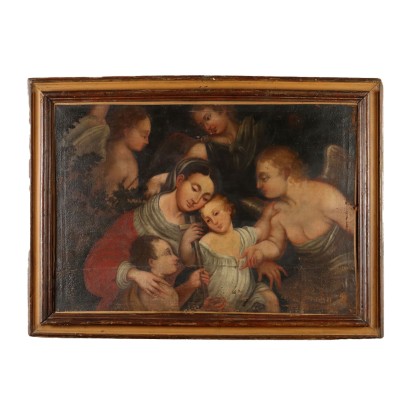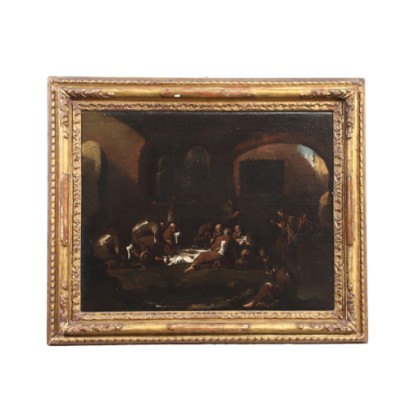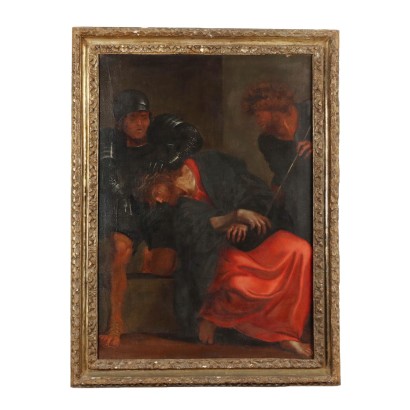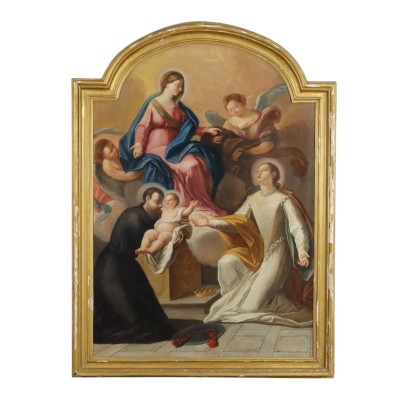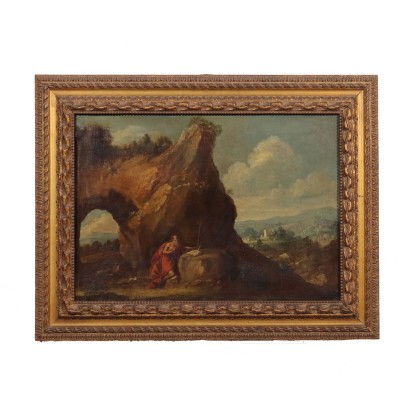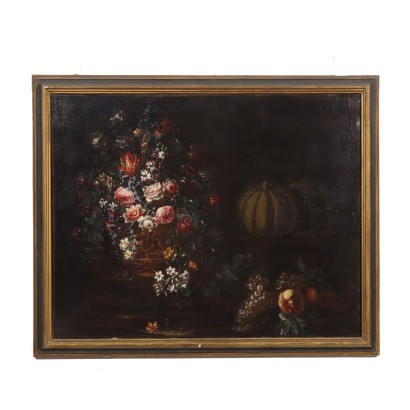Sic Transit Gloria Mundi Oil on Canvas France XVII Century
Features
Artwork title: "Sic transit gloria mundi"
Artistic school: French School
Age: 17th Century / 1601 - 1700
Subject: Allegorical/Mythological Subject
Origin: France
Artistic technique: Painting
Technical specification: Oil on Canvas
Description : "Sic transit gloria mundi"
Oil on canvas. French school of the seventeenth century. The scene is set in front of an open arch in a stone structure, which gives access to uninhabited and bare rooms. Two figures, a woman and a putto, are delighting with different instruments: she plays a mandolin and, scattered on the ground, there is a palette of colors, books, jewels, armor and weapons, other musical instruments, and a globe. on which the putto stands, producing soap bubbles; on the ground in the center, a cartouche mentions the saying \"Sic transit gloria mundi\". This is a famous Latin phrase, which in Italian means \"Thus passes the glory of the world\", used to emphasize the ephemeral value of the things of life, symbolized by various objects (arts, literature, wealth ...), destined to vanish like soap bubbles. The whole scene therefore has a strong allegorical / symbolic meaning: even the sunset, which can be glimpsed on the left, expresses the same concept, everything in the world is destined to end. The theme of the transience of life, always present in art, had its maximum development in the seventeenth century, closely related to the sense of precariousness that hit the European continent following the Thirty Years' War and the spread of plague epidemics. With allegorical scenes like this, rather than with the Vanitas or Memento mori, or scenes or still lifes with symbolic elements alluding to the theme of the transience of life (the skull, the candle that is consumed, a clock, a broken flower), we wanted precisely to emphasize the ephemeral condition of existence, of man and earthly goods. On the back of the work there is a cartouche that says a probable attribution to Simon Vouet. The painting, restored and relined, is presented in a re-adapted antique frame.
Product Condition:
Product in good condition, with small signs of wear.
Frame Size (cm):
Height: 76
Width: 90
Depth: 6
Artwork dimensions (cm):
Height: 50
Width: 64
Additional Information
Artistic school: French School
Age: 17th Century / 1601 - 1700
17th Century / 1601 - 1700Subject: Allegorical/Mythological Subject
Artistic technique: Painting
La pittura è l'arte che consiste nell'applicare dei pigmenti a un supporto come la carta, la tela, la seta, la ceramica, il legno, il vetro o un muro. Essendo i pigmenti essenzialmente solidi, è necessario utilizzare un legante, che li porti a uno stadio liquido, più fluido o più denso, e un collante, che permetta l'adesione duratura al supporto. Chi dipinge è detto pittore o pittrice. Il risultato è un'immagine che, a seconda delle intenzioni dell'autore, esprime la sua percezione del mondo o una libera associazione di forme o un qualsiasi altro significato, a seconda della sua creatività, del suo gusto estetico e di quello della società di cui fa parte.Technical specification: Oil on Canvas
The oil painting is a painting technique using powder pigments mixed with bases in inert and oils.Other customers have searched:
Se sei un appassionato d'arte, non perderti i nostri approfondimenti sul Blog Arte Di Mano in Mano e su FineArt by Di Mano in Mano - Arte:
Ecco alcuni tra i principali articoli:
Breve Storia del Collezionismo
Giorgio Upiglio, maestro dei libri d'artista
Matthias Withoos detto "Calzetta bianca"
San Rocco pensaci tu - Classic Monday
Dai un'occhiata alle nostre rubriche di divulgazione sull'arte:
Epoche
Lavorazioni e tecniche
Mostre ed Eventi
Protagonisti
Se sei appassionato di pittura antica, con tutta probabilità gusterai le schede di questi stupendi quadri:
"Dio parla a Noè dopo il diluvio", Jacopo da Ponte, detto il Bassano, seconda metà XVI secolo
Crocifissione, maestro della misericordia dell'accademia, terzo quarto del XIV secolo
Erminia incontra i pastori, Camillo Gavassetti, Seconda metà anni Venti del XVII Secolo
Eroine dell'antichità, Francesco Conti, XVIII secolo
Hieronymus III Francken, La Negazione di Pietro, XVII secolo
Jefte e la figlia, Girolamo Forabosco e aiuti, XVII secolo
L'Accademia di Platone, piccolo arazzo, fine XVII - inizio XVIII secolo
Maddalena e San Giovanni Battista
Natura Morta, Bartolomeo Arbotori, XVIII secolo
Sacra Famiglia con San Giovannino, Bartolomeo Ramenghi, scuola di, prima metà XVI secolo
Testa Femminile, Andrea del Sarto, ambito di, post 1522
Uva, fichi, melagrana e pesche su un capitello - Maximilian Pfeiler, primo quarto XVIII secolo
Sapevi che l'arte può essere anche un ottimo investimento (e non solo per grandi portafogli)?
L'Arte tra Collezionismo e Investimento
FineArt: Arte come investimento















